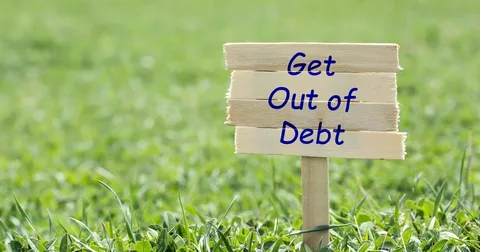Not every debt(out of debt) is harmful. However, poor debts may put a burden on your back and lead to ongoing financial stress.
Table of Contents
The good thing about bad debt is that it is reducingable.
Once you have a clear picture of all the accounts and amounts you owe, you may utilize the following advice to pay off your debt.
Reevaluate your spending patterns
You separate your purchases into “nice to have” and “need to have” categories. “Need to have” items include clothing, food, housing, utilities, and transportation. Every other thing is just “nice to have.”
As you reduce your debt, you cannot cut corners on your “need-to-have” purchases. However, you may spend less on “nice-to-haves” and apply the additional money to your loan or credit card amount.
Resign your membership to the gym you never visit. Reduce how often you eat out or drink coffee. Give up on that unused streaming subscription. Get rid of a $15 monthly streaming subscription to save an extra $180 a year that you may use to pay off debt.
Choose the reward strategy that best suits your circumstances.
Two popular methods of debt repayment are avalanche and snowball.
Debt snowball: least amount due initially

By using the debt snowball method, you pay the minimum amount owed on all loans and credit accounts, with the exception of the account with the lowest balance, to which you allocate any excess funds. After paying that amount, go on to the account that has the next-smallest balance and take care of it. Follow this strategy until your debt is settled.You may pay down accounts faster since the available amount “snowballs” into a greater sum when balances are paid down.
The fast wins are the key advantage of the snowball tactic. You may be inspired to keep going if you see your credit card amount reach zero in a matter of months. However, even if you’re making smaller payments, the balances in your higher-interest accounts are increasing, which might make this strategy more expensive.
A debt snowball that is starting huge
When using the debt avalanche method, you pay the minimal amount due on each account. Your money and attention are directed toward the greatest interest-rate balance. Once the debt is zero, focus on reducing the credit card or loan that has the next highest interest rate.
By paying off the highest-interest bills first, the debt avalanche method lowers your overall interest costs. Nonetheless, persistence and drive are needed for this tactic. The greatest balance accounts in your portfolio may also have higher interest rates, meaning they may take longer to settle.
Exceed the minimal
When you pay more than the minimum on a credit card or loan, you save money on interest rates and help the account reach zero balance sooner.
Suppose you have a $5,000 credit card balance with a 20 percent interest rate. It will take more than nine years (109 months) to pay off that sum if you make a $100 monthly payment on it. Nevertheless, the payback period is shortened to just two and a quarter years (33 months) when that payment is increased to $200.
Your credit usage ratio can be lowered by making larger than minimum payments. This percentage shows you how much of your available credit you really use. Your credit score is raised when your usage ratio is decreased.
You can find out the minimum payment amounts, interest rates, and the length of time it takes to pay off a credit card debt with Bankrate’s credit card repayment calculator.
Assign more funds to the accounts.
Cutting back on expenses is one approach to get additional money. Unexpected sums, both big and little, can also be used to lower those debt levels.
Making use of the windfall
If you’ve had a windfall—say, a sizable tax return, a bonus at work, or cash from a giving relative—apply some of it to your debt and save the rest for a fun activity or a special night out for yourself. A tiny bit goes a long way toward reaching your debt-reduction objectives.
Make a tiny profit
The debt snowflake method is another way to reduce your debt. You must identify little saves and apply those additional to debt in order to use this strategy. Many methods exist for doing this, such as:
- Purchasing generic goods
- Making purchases using coupons
- Carpooling to save petrol costs
- Cutting back on power and water use
No, paying off debt with a few bucks a week won’t happen overnight. However, consider how many snowflakes it takes to build substantial drifts. Small savings might also assist in lowering your debt.
Take into account debt consolidation strategies
One approach to manage your debt is to take out a debt consolidation loan or move your balance to a credit card with 0% APR. With one of these options, you may settle debt from several lenders and creditors, leaving only a single monthly payment that goes toward the remaining amount on your loan or credit card.
Budgeting may be simpler with this method because you’re only paying for one instead of several. Because you’ve avoided paying interest on many credit cards and loans, you could also find yourself having extra money to make that payment.
But before you sign on the dotted line, be sure you understand things like interest rates and loan terms—that is, how long you have to pay back the money.
Start a plan to handle your debt.
You can benefit from a debt management plan (DMP) in the following ways:
•To manage your money, you create a budget in collaboration with a credit counseling organization.
•That organization bargains concessions with creditors, such as waived fees or lowered interest rates.
•You pay the credit counseling service once a month, and it pays each creditor if the creditors comply.
A few disclaimers apply here. First off, trustworthy DMP providers are usually nonprofit, although your monthly payments will probably include a cost.
Secondly, while on the plan, it is not a good idea to take out loans or establish new credit lines. The DMP is intended to help you pay off debt, not take on more. Additionally, creditors and lenders may be hesitant to provide you a credit card or loan if you recently entered a DMP, which may appear on your credit record. If they do, they could only provide bad credit rates, which include a higher annual percentage rate (APR) or charge.
Accept less than what you are due.
Through a debt settlement program, you can negotiate a lower payment with your creditors than what you are now owed.
You have two options: do it yourself or use a third-party debt settlement business to handle negotiations with creditors. Depending on the details of the contract, you could pay less in total than what’s due (in the form of a lump amount) or have fees and interest waived or lowered.
According to Jennings, debt settlement is a possibility for those who are unable to fulfill their financial commitments. He said, though, that “it may have tax implications on the forgiven debt and may significantly impact credit scores.”
In summary
Not ideal is bad debt. Nonetheless, it is eradicable. You may improve your financial situation and lower your debt by implementing the aforementioned measures. In order to avoid repeating your mistakes once your debt is completely paid off, consider and alter the actions that led you there in the first place while you’re paying off your debt.
Frequently requested inquiries
- What is the issue with excessive debt? If you use credit cards for regular purchases or to settle other bills, you may have too much debt. If you are limited to making the minimum payments on those cards, that is also problematic.Debt may also have an emotional effect, according to CFA Charterholder and Qualified Financial Advisor (QFA) Ian Jennings. According to Jennings, “strained relationships, a lower quality of life, and limited financial freedom can result from financial strain.” “Reducing and managing debt is essential to achieving financial security and general well-being.”
- Does having a high debt load imply having a low credit score? Maybe, but don’t let it deter you from making efforts to reduce your debt.The Fair Isaac Corporation (FICO), which accounts for 35% of a credit score overall, places a premium on payment history when assessing credit health. Your credit utilization, or the amount of debt you have relative to your credit limit, accounts for 30% of your score.If you have maxed out your credit cards (which may happen if you have a lot of debt), your credit score may suffer even if you make all of your payments on time. To raise your credit score, use no more than 30% of your available credit. Maintain your debt below $1,500, for instance, if your credit score is $5,000 overall.
- Which budget works best for paying off debt? The 50/30/20 budget is a useful strategy for debt repayment. Using this method, you allocate 50% of your net income to “need-to-have” costs and 30% to discretionary (non-essential) spending. The remaining twenty percent goes toward debt reduction and savings.Consider allocating a portion of that 30% toward your credit card debt in order to pay off debt faster.

